Final report for LNE19-379
Project Information
Leek moth, a pest of members of the Allium family, and whose larvae feed on crop foliage, causes stunting of plant growth, and compromises the marketable yield of fresh alliums and the quality of alliums in storage. Our team took a participatory action research (PAR) approach, inquiry in which researchers and stakeholders work together to understand a problem and identify potential solutions, to address this emerging threat to Northeastern allium production. Our research approach explored pre- and post-harvest tactics for reducing the impact of leek moth damage on marketable allium yields, while our educational approach focused on practical information to aid farmers in applying sustainable leek moth management.
We tested the efficacy of the commonly available generalist egg parasitoid, Trichogramma brassicae, as a biological control for leek moth, and the effect of variable “topping” lengths for the reduction in the number of leek moth exit holes and subsequent reduction in marketability of onions post-harvest. The release of T. brassicae within onion plots significantly reduced the incidence of leek moth damage in onion leaves by an average of about 50%, topped onions exhibited significantly less leek moth exit holes when compared to onions cured with intact leaf tubes and then topped before storage, and topping did not significantly affect onion quality after six months of cold storage.
Our educational program included resources for farmers that detailed the ecology, identification and pest management strategies for leek moth. Over the course of the project, we hosted webinars and on-farm workshops, provided one-on-one technical assistance, shared timely updates over email and listservs, created an updated leek moth fact sheet, as well as shared the results of this project at state and regional grower conferences, and national conferences of the scientific community. Ultimately, we created of an updated Leek Moth Information Center for the United States, now hosted by UVM Extension: https://www.uvm.edu/extension/leek-moth-information-center.
The benefits identified by the growers engaged with our research and education program were in two broad categories - knowledge building and skills development. Knowledge built included increased awareness of leek moth and its ecology within the region, the impact of leek moth on onion yields, the potential leveraging of onion varietal differences. While skills developed included scouting and monitoring protocols, proper timing of chemical applications for leek moth control, appropriate usage of exclusion strategies (e.g. row-cover, insect netting, etc.), deploying parasitoids, selecting resistant cultivars, and effective pre-curing topping. Farmer-to-farmer communication facilitated our research and education programs through the direct sharing of the benefits and challenge of our various approaches.
Fifty Northeastern growers will implement new sustainable leek moth management tactics, pre and/or post harvest, on 150 acres of allium cropland protecting $400,000/year worth of harvested alliums. Of these fifty growers, five will report their estimated average recovery of losses.
For several years, our research team documented the advancing leek moth (LM) invasion via an externally funded statewide monitoring program here in Vermont. According to our longitudinal catch data, we estimated the moth’s rate of expansion conservatively at approximately 33 miles per year. Recent reports of LM damage from several farms in western Maine validate our estimation and suggest that the moth is likely to reach the Atlantic coast of the USA in the next several years. Considering the pest’s rapidly expanding distribution, allium crop losses are projected to increase substantially in the upcoming years. The 2012 Ag Census estimated that over 520 farms within Vermont and New York grew allium crops totaling close to 8000 acres (US Census of Agriculture, 2012). With Maine allium growers in the cross hairs of the LM expansion, the impacted acreage will undeniably increase as the moth moves east through Maine and south through Massachusetts.
Marketable damage from LM can occur at both the pre and post-harvest stages of crop management. First, during the primary crop growth stage, larval feeding by LM can defoliate, damage and/or reduce the photosynthetic potential of hosts plants leading to reduced yields. In addition, wounds associated with larval feeding may expose host plants to secondary diseases and pest infestations leading to even greater crop losses. Finally, post harvest damage from LM larvae can often lead to substantial losses in marketability during crop storage. Losses incurred during curing and storage have been reported by up to 40% of our monitored farms over the past three years.
This project tested both pre and post-harvest tactics for reducing the impact of leek moth damage on marketable allium yields. These included: the release of a commonly available parasitoid wasp and adaptive curing practices to reduce bulb damage from late season LM larvae. These two tactics provided farmers with adaptable and affordable low-tech options for managing LM in allium crops. Furthermore, the development of non-chemical options for the control of LM both reduced the dependency on chemical controls, lowering the risk of pesticide resistance and helping to diversify the current IPM toolbox for more sustainable control of the LM.
Through our educational plan we also provided growers with up to date information on the state of the invasion within their region. For those farmers that have yet to experience LM or are outside the moth’s current distribution, they received diagnostic support materials (e.g. updated factsheet and website, photographs, etc.) and trap identification tools through our online and in-person workshops. Also, farmers received education regarding the ecology of the pest and training for successful on-farm LM monitoring. Strategies for LM management generally require precise timing for effective control. Regardless of the adopted tactic(s) (e.g. cultural, chemical, etc.) farmers are now aware of the basic population dynamics associated with LM under field conditions. Finally, many farmers joined our monitoring efforts, and this network provided the most efficient and effective dissemination of our co-created knowledge.
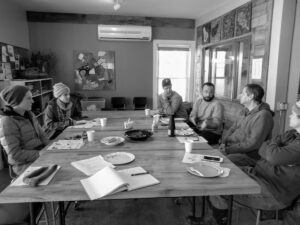
Cooperators
- (Educator and Researcher)
- (Educator and Researcher)
Research
Hypothesis I: Releasing Trichogramma brassicae during leek moth flights significantly affects pest pressure associated with the leek moth larvae in onion plantings.
Hypothesis II: Topping onions at harvest significantly affects the incidence of leek moth exit holes and marketability of onions while in storage.
The following research design was the product of an ongoing Participatory Action Research (PAR) project whereby participating growers identified their most preferred treatments. Based on this information, we chose to conduct field trials to test the two most popular options:
1) To test the efficacy of the commonly available generalist egg parasitoid, Trichogramma brassicae, as a biocontrol for LM (originally proposed by Andy Jones - Intervale Community Farm).
2) To test the effect of variable “topping” lengths for the reduction in the number of LM exit holes and subsequent reduction in marketability of onions post-harvest (originally proposed by Christa Alexander - Jericho Settlers Farm).
Hypothesis I: Releasing Trichogramma brassicae during leek moth flights significantly affects pest pressure associated with the leek moth larvae in onion plantings.
In all three years of the project we conducted field trials on two UVM-associated research farms – the UVM Horticultural Research and Education Center (HREC) in South Burlington, VT and Borderview Research Farm (BRF) in Alburgh, VT. In addition, on-farm trials were conducted commercial diversified farms identified as high risk through our existing monitoring program – Interval Community Farm in Burlington, VT, Jericho Settlers Farm in Jericho, VT, Bear Roots Farm in Williamstown, VT, Dog River Farm in Berlin, VT, and Pete's Greens in Craftsbury, VT.
In the spring of each growing season, two 175ft-long beds were established, at least 200m apart from one another at HREC/BRF, in fields that were cover cropped, plowed, disked, and fertilized using Pro-Grow and compost. They were then formed into 40in-wide beds with black plastic and drip tape for irrigation. At HREC/BRF, Sedona variety bare rooted onions transplants (Sunbelt transplants, Buckeye, AZ) were planted singly with 3 rows per bed and 4in spacing within rows, in mid-to-late May. A cultivating tractor and/or hand-cultivation was used for weed control between beds, but no insecticides were used for insect control throughout the trials. Specific horticultural practices (e.g. bed prep, plant spacing, weed management, etc.) at each commercial farm site was based on their own best practices, and thus varied from each other and from the research farms, however the growers refrained from pesticide applications during the parasitoid releases. Experimental treatments, beds treated with Trichogramma releases and untreated controls, were randomly assigned to one of each bed at all research sites (six in 2020 and five in 2021).
For the experimental treatments, Tricho-Gard® sachets from Anatis Bioprotection (each containing 4,000 Trichogramma brassicae pupae), were deployed weekly during the second and third LM flights, through to onion harvest. One Tricho-Gard® was placed in the center of the bed, every 25ft per the recommendations of Anatis Bioprotection, based on their work with garlic and leek growers in Quebec. The exact timing of LM flights was determined through the use of pheromone traps set up at each location; roughly mid-June through the end of July. Untreated controls contained no Tricho-Gard® sachets.
Anatis Bioprotection also provided pasteurized Mediterranean flour moth (Ephestia kuehniella) eggs that were placed within both experimental treatments beds and untreated control beds. These sentinel eggs were used to confim the viability of the Trichogramma wasp releases in the treatment plots and confirm there were no native/endogenous parasitoids within the control beds. Sentinel eggs were glued to paperboard cards with nontoxic glue and the cards were tied to onion plants every 25ft along the beds with flagging. Sentinels eggs were replaced semiweekly at each location throughout release period. After the sentinels were in the field for a half-week, they were placed in 16oz deli containers (Solo Cup Co.), brought back to the lab, and kept on a bench at room temperature to rear out potential parasitoids. Prior to harvest, presence/absence of LM larval feeding damage was assessed on 10 onion plants at 10 randomly chosen spots (100 plants) in the control and release plots at each site.
For statistical analysis, damage incidence was designated as a dependent variable, and differences among treatments was determined via a generalized linear model for damage incidence. Trichogramma treatment (i.e. released parasitoid) was considered the single fixed factor. Farm site, trial year and their associated interactions will be considered random effects.
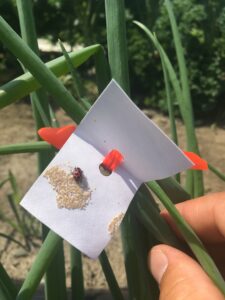

Hypothesis II: Topping onions at harvest significantly affects the incidence of leek moth exit holes and marketability of onions while in storage.
In all three years of the project topping trials were conducted with onions grown at the HREC and BRF. In the spring of each growing season, a 175ft-long bed were established (at least 200m away from beds with Trichogramma released described in the methods above, to remain independent) in fields that were cover cropped, plowed, disked, and fertilized using Pro Grow and compost. They were then formed into 40in-wide beds with black plastic and drip tape for irrigation. Sedona variety bare rooted onions transplants (Sunbelt transplants, Buckeye, AZ) were planted singly with 3 rows per bed and 4in spacing within rows, in mid-to-late May. A cultivating tractor and hand-cultivation were used for weed control between beds, and no insecticides were used for insect control throughout the season.
At harvest, onions were topped using hand shears to remove the foliage at variable lengths, as described by Wright et al. (2001). Experimental treatments included onions clipped at 1in, 6in, and 10in from the shoulder, and an uncut control (i.e. full length leaf tube). Fifty onions from each site were randomly selected for each treatment (50 onions x 4 treatments = 200 total at each site). Onions were then placed in a well-ventilated hoop house at the HREC with large exhaust fans to ensure proper curing. Bulbs were considered cured when the neck tissue was dry, approximately three weeks. Dried foliage was removed from onions in all of treatments to be even with 1" treatment after curing, using hand shears.
After all of the onions from each treatment/site were cured, LM damage incidence (presence/absence of exit holes) and yield (weight in lbs) was measured for each bulb. Onions were then placed in nylon string bags and stored in a walk-in refrigerator at 5 degrees Celcius and approximately 70% RH. Six months post curing, onion “storability” and “quality” was determined using incidence of rot and a degrees Brix test, respectively. All onions were cut open, presence/absence of rot recorded, and a sample from the center pulverized using a hand press, filtered with a Kimwipe, and placed in the sample well of a refractometer.
For statistical analysis, dependent variables included: damage incidence, yield, rot incidence, and degrees Brix values. Differences among topping lengths were evaluated using a generalized linear model with topping length as a fixed factor and year, site and their associated interactions as random effects.
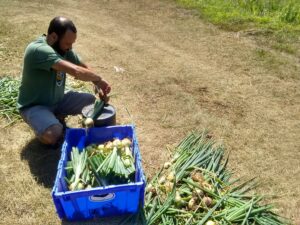
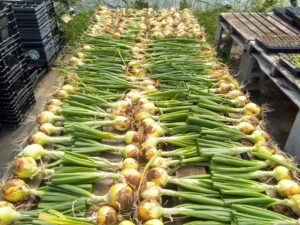
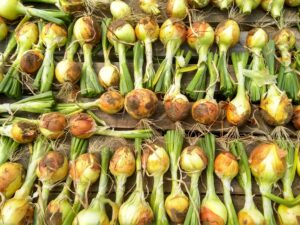
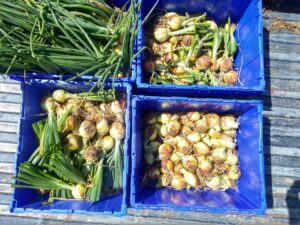
Leek Moth Distribution
Thanks to the efforts of numerous growers throughout the NY/VT region, our research team has been tracking the expansion of the leek moth distribution from its original introduction in northern NY. According to the most recent information provided by farmers and service providers in the Northeast, the known distribution of the moth, indicated in yellow, includes northeastern NY, a large majority of VT, northern NH and western Maine (Figure 1.)

Parasitoid release trials
1) To test the efficacy of the commonly available generalist egg parasitoid, Trichogramma brassicae, as a biocontrol for LM (originally proposed by Andy Jones - Intervale Community Farm).
2019 Field Season
In collaboration with the Canadian biological control company, Anatis Bioprotection, we tested the efficacy of the parasitoid wasp, Trichogramma brassicae, as a biological control option for managing LM in onion crops. Data from the 2019 field trials replicated across six Vermont farms were promising. The release of T. brassicae within onion plots significantly reduced the incidence of LM larval damage in onion leaves (Figure 2) across all farms. given the success of the Trichogramma releases, our team continued trials to include with hopes of confirming the efficacy of releasing T. brassicae to manage LM.
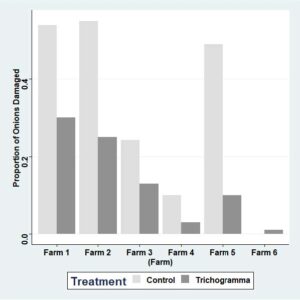
2020 Field Season
Due to the COVID-19 pandemic and the resultant modified field protocols, we modified our commercial farm collaborators for the 2020 field season. The participating farms included two research farms: Borderview Farm (Alburgh, VT) and the Horticultural Research Farm at UVM (Burlington, VT) and three commercial farms: Dog River Farm (Berlin, VT), Pete's Greens (Craftsbury, VT) and Intervale Community Farm (Burlington, VT.)
As a general trend across all of the 2020 trichogramma release field trials, leek moth pressure, measured as leaf damage incidence, was substantially lower in comparison to the previous year (2019). Three (out of 4) of the replicated field trials displayed less than 1% total LM incidence in both the control and release plots. The HREC field trial, the sole trial with significant larval damage, displayed no difference between the control and release plots. The inconclusive results from the 2020 trials is likely the result of the interaction of climatic factors and the physiology of both the LM and the trichogramma wasps. Insects populations are particularly sensitive to extreme temperatures and fluctuations in humidity. Growth rates and developmental times for most insects are directly correlated with ambient temperature. However, there are upper and lower temperature thresholds for insect development. Temperatures above or below these thresholds can significantly reduce population growth rates leading to reduced pest pressure and poor natural enemy performance. The 2020 summer growing season was typified by extreme temperatures and drought across much of the region, including Vermont. Provided these conditions, the suppression of LM pressure in 4/5 of the field trials is not a surprising result. Similarly, the lack of significant difference between the control and release plots within the HREC field trial is likely the result of the stunted development of the released trichogramma wasps.
2021 Field Season
Once again the release of T. brassicae within onion plots significantly reduced the incidence of LM larval damage in onion leaves (Figure 3) across all farms. At the Burlington site, we trialed a spray-on form of T. brassicae, which may have slightly reduced the efficacy, though that was not tested.
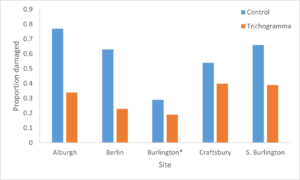
Onion Topping
2) To test the effect of variable “topping” lengths for the reduction in the number of LM exit holes and subsequent reduction in marketability of onions post-harvest (originally proposed by Christa Alexander - Jericho Settlers Farm).
2019 Field Season
LM Damage Assessment during Curing
Onion topping displayed a significant effect on the incidence of LM pressure during curing (and likely during storage). "Topped" onions exhibited significantly fewer larval exit holes when compared to onions cured with intact leaf tubes (Figure 4). Storage quality data will be collected after six months of storage at the recommended storage conditions for onions. These results suggest that topping prior to curing may prevent sequestered leek moth larvae from feeding upon stored onions. In addition, larvae are likely found farther than 10'' from the shoulder of the bulb at the time of harvest.
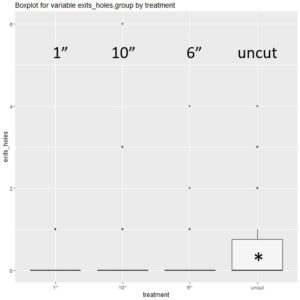
Surprisingly, bulbs topped 10'' from the shoulder exhibited significantly higher masses after two weeks of curing (Figure 5). The physiological mechanism(s) leading to these results was not readily apparent at this time. Feedback from several plant physiologists suggested that something other than the topping must have provided the mechanisms the resulted in the difference and it was not a treatment effect.
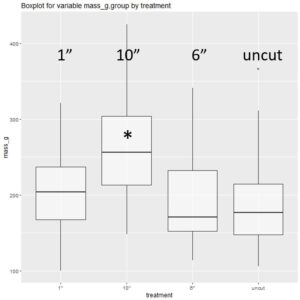
2021 Field Season
Onion topping displayed a significant effect on the incidence of LM pressure during curing (Figure 6). "Topped" onions exhibited significantly fewer larval exit holes when compared to onions cured with intact leaf tubes for those onions grown at Borderview Research Farm, and though the uncut onions from HREC had more exit holes, that difference was not significant.

Onion Storage Quality
2019 Field Season (Completed in April 2020)
Onion topping did not significantly affect onion quality after six months of cold storage across both research trials. However, for onions harvested from Borderview research farm, topping length did display a significant effect on storage. Because we did not determine the cause of the rot, it is difficult to deduce the reason(s) for the difference in damage incidence between the two farms. Both uncut onions and onions cut at 10'' from the shoulder of the onion exhibited significantly higher incidence of onion rot, 10% and 12% respectively. The direct mechanism(s) for these differences, again are not easily discernible from the current data set as the observed pathologies (i.e. rotted onion layers) were not characterized as pathogens or abiotic causes.
| Percentage of onions displaying rot (n=50) | ||
| Inches from shoulder | Horticultural Research Farm | Borderview Research Farm |
| 0 | 0% | 10% |
| 1'' | 4% | 6% |
| 6'' | 0% | 4% |
| 10'' | 0% | 12% |
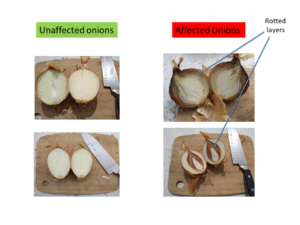
2020 Field Season (Completed in April 2021)
Onion topping did not significantly affect onion quality after six months of cold storage across both research trials. Sugar content (degrees Brix) was between 11-11.5% for all four treatments and was not significantly different (Figure 7). The onion topping quality assessment was considered inconclusive due to a lack of rot in onions from any of the treatments six months after storage.

LM Damage Assessment during Curing
The onion topping damage assessment was considered inconclusive due to a lack of documented leek moth damage (i.e. larval exit holes) in post-cured bulbs.
Efficacy of the commonly available generalist egg parasitoid, Trichogramma brassicae, as a biocontrol for leek moth
The release of T. brassicae within onion plots significantly reduced the incidence of LM larval damage in onion leaves by an average of about 50% across the entire project.
Effect of variable “topping” lengths for the reduction in the number of LM exit holes and subsequent reduction in marketability of onions post-harvest
Topped" onions exhibited significantly fewer larval exit holes when compared to onions cured with intact leaf tubes and then topped before storage. These results suggest that topping prior to curing may prevent leek moth larvae from feeding upon stored onions by excluding them from curing. Onion topping at harvest did not significantly affect onion quality after six months of cold storage. Topped onions were no more prone to rot than those with intact leaf tubes, and the sugar content (degrees Brix) was between 11-11.5% for all four treatments and was not significantly different.
Education
Recruitment
Initial farmer recruitment for educational events, knowledge transfer and workshops began with direct recruitment from our current network of growers in our monitoring program. Further recruitment within the region was achieved with the help of Extension professionals in New England and New York.
Educational Curriculum
Our curriculum focused on adaptable information to aid farmers in applying sustainable IPM tactics both new and old. General knowledge of the phenology and ecology of LM was essential for the success of our educational program, as this allowed for proper deployment of tactics. Additionally, we reported the results of our field trials in conjunction with trainings for successful application.
As part of our program we utilized an information “flip” booklet, developed by Cornell Cooperative Extension, detailing the ecology, identification and pest management strategies for LM. Following the completion of the final field season of this project created an update to these booklets that included the results of our management trials and techniques for applying the newly derived knowledge. In addition, we added information on
LM that was not directly associated with our own project. The informational material was distributed electronically to previously identified farmers during the winter following our final field season.
Webinars (such as VVBGA webinar 10-2020), individual consultations, and site visits over two years supported our educational program and and the subsequent adoption by growers. Farmers received assistance with individualized deployment from the project team. Farmer-to-farmer communication through farm demonstrations, PAR meetings and postings to regional Veg and Berry Listserves, also facilitated farmers utilizing the techniques we tested since farmers communicated to others about the benefits and challenges. Results from our trials were also posted on the https://www.uvm.edu/agroecology/research/vepart. Cornell decided to retire their leek moth information website and contacted our team towards the end of the project. This lead to an unexpected and welcomed development, the creation of an updated Leek Moth Information Center for the United States, now hosted by UVM Extension: https://www.uvm.edu/extension/leek-moth-information-center.
In addition, we presented the results of this project at regional and national conferences including: Winter NOFA conferences, the Entomological Society of America Annual Meetings, and the Vermont Vegetable and Berry Growers Annual Meetings. We will also held a biocontrol workshop at a HREC to provide technical support. Instructional materials (hard copies and/or electronic) detailing IPM tactics complete with our research findings shared at all conferences/workshops. We intend to prepare manuscripts that will be submitted for publication to appropriate peer-reviewed scientific journals.

Technical Assistance
Technical assistance for LM scouting, monitoring, and management measures was offered to growers via phone, one-on-one meetings and on-farm consultations throughout the project.
Milestones
1) One hundred northeastern vegetable growers (from NY, NH, VT and Maine) will receive a survey to assess general LM knowledge, LM pressure in alliums and willingness to adopt new organic practices including those being tested in the research portion of this project.
100
250
10
June 30, 2019
Completed
December 12, 2019
Year 1 (2019) We distributed our survey in three capacities:
- Distributed the survey to our participatory research farmer network via direct email, 50 growers in total.
- Distributed surveys during our Master Gardener outreach event "Hand's on insect identification" on July 22, 2019 at the Horticultural Research and Education Center (HREC) ~30 participants
- Distributed during our Master Gardener outreach event "Identifying Veg Pests and Diseases" Aug 22,2019 at HREC ~ 25 participants
- Distributed surveys to 150+ growers at the 2019 New England Fruit and Vegetable Growers Conference, Manchester, NH.
2) Seventy-five growers will return the survey; 40 of which will agree to participate in the education and
Outreach program including education on available biocontrol suppliers and possible on-farm consultations.
a. Forty growers return survey; 20 of which will agree to participate in the education and outreach program including education on available biocontrol suppliers and possible on-farm consultations. August 2019
b. Thirty-five will return survey; 20 of which will agree to participate in the education and outreach program including education on available biocontrol suppliers and possible on-farm consultations. June 2020
40
85
June 30, 2020
Completed
August 10, 2019
Forty growers from our in-person outreach events volunteered to be a part of our education program. These growers joined our existing grower network partners, totaling 85 farmers who took part in the initial survey and subsequent educational programming
3) Three growers will volunteer to host field days detailing the project on their farms over a two year period.
a. One grower will volunteer to host a field day in August 2019
b. One grower will volunteer to host a field day in August 2020
c. One grower will volunteer to host the final field day in August 2021
3
4
August 31, 2021
Completed
August 31, 2021
The Intervale Community Farm (Burlington, VT), Borderview Farm (Alburgh, VT), Bear Roots Farm (Williamstown, VT) and Catamount Farm (Burlington, VT) each volunteered to host a field day during the project.
Due to COVID-19 restrictions and UVM policies participating farms were unable to host any in-person events for the 2020 growing season. In 2021, the many of the pandemic-related restrictions were still in place, and hesitancy among growers to host and attend workshops led to a change in outreach that focused on virtual events.
4) The forty participating growers will receive LM monitoring updates on the phenology of the pest during the research period.
a. For year one, updates will be sent out three times during the growing period with the final update being
distributed in early August 2019.
b. For year two, updates will be sent out three times during the growing period with the final update being
distributed in early August 2020.
c. For year three, updates will be sent out three times during the growing period with the final update being distributed in early August 2021.
40
250
August 31, 2021
Completed
August 31, 2021
During the 2019 and 2020 growing season we distributed email updates (both direct emails and listserve posts) that coincided with the beginning of each adult leek moth "flight", three in total. We can verify that 50 of our farmer network partners received these updates. In concert with these emails we also distributed our updates via the Vermont Vegetable and Berry Growers Association (VVBGA) listserve. In 2021, we began a pilot program with the VVBGA that involved weekly pest and disease updates. Those scouting results, along with management information was emailed weekly through the list-serv with a link to more detailed information at the following website: https://blog.uvm.edu/vepart-scouting/
5) Updates on the research trials will be distributed at the end of each field season. This consistent communication will increase the likelihood that farmers will participate in the M&E for the project goals and adoption.
a. For year one, research trial data and analysis will be sent out to growers in December 2019
b. For year one, research trial data and analysis will be sent out to growers in December 2020
c. For year one, research trial data and analysis will be sent out to growers in December 2021
40
85
December 20, 2021
Completed
January 31, 2022
The 2019 research brief can be found at https://www.uvm.edu/agroecology/vepart-publishes-new-research-brief/. This brief was distributed directly to our farmer networks, our recent survey participants and the VVBGA newletter.
The 2020 research brief can be found at https://www.uvm.edu/agroecology/media/pdf/2/0/2/2020-Leek-Moth-Research-Brief-FINAL.pdf. This brief was distributed directly to our farmer networks, our recent survey participants and the VVBGA newletter.
The 2021 research brief can be found at https://www.uvm.edu/agroecology/vepart-research-brief-2021-field-season/. This brief was distributed directly to our farmer networks, our recent survey participants and the VVBGA newletter.
6) Two-hundred and fifty northeastern vegetable growers attending the annual Northeast Organic Farmers Association (NOFA) Summer Conferences, associated state Winter Conferences, and New England Vegetable & Fruit Conference participated in a series of info sessions and workshops detailing the most successful pest control tactics gleaned from the previous research and current on-farm research trials.
a. Following the first field season, we attended the 2019 New England Vegetable and presented our preliminary findings from our monitoring and field trials for 200 growers and close to 100 extension professionals. December 2019
b. We will present our preliminary findings and monitoring information for 75 growers and gardeners
attending the 2022 NOFA-VT Winter and 2022 Vermont Vegetable and Berry Growers Association
meetings. January/February 2022
c. We will attend the 2022 Winter VT NOFA conference and present our first three years of data from our
monitoring and field trials for up to 75 growers and gardeners. January/February 2021
d. During the 2021 field season we will present our 2020 findings at the 2021 Summer Northwest Crops and Soils Field day in VT. This info session will provide upto 50 growers and gardeners the most up to date information on our research. August 2021
e. Final data and analysis will be shared via a presentation for 150 growers attending the 2021 New England Vegetable and Fruit Conference and the 2022 Vermont Vegetable and Growers Association Winter meeting. December 2021
f. Final data and analysis will be shared via a presentation for 150 growers attending the 2021 New England Vegetable and Fruit Conference and the 2022 Vermont Vegetable and Growers Association Winter meeting January 2022
250
494
100
January 31, 2022
Completed
January 31, 2022
We shared our work with approximately 200 growers during our presentation session at the 2019 New England Vegetable and Fruit Conference. We also presented our research as part of the 2020 Vermont Vegetable and Berry Growers' Association (VVBGA) webinar series ( https://www.uvm.edu/extension/horticulture/vermont-vegetable-and-berry-grower-webinar-series), 16 attendees viewed the presentation live and many others have accessed the video since that time. Furthermore, we were invited to share our 2020 research results at the UVM extension monthly organization meeting, attended by over 100 Extension professionals, and the UMass Extension Commercial Agriculture Team. We presented our research to 254 growers during our presentation session at the 2021 New England Vegetable and Fruit Virtual Conference.
7) Fifteen high risk growers will receive personalized assessments and coaching for implementation of the tactics being tested in the research field studies.
a. Five of these farms will be contacted in year one of our field trials to assess the best course of possible
action on their farms to reduce the impact of LM. September 2019
b. Five of these farms will be contacted in year one of our field trials to assess the best course of possible
action on their farms to reduce the impact of LM. September 2020
c. Five of these farms will be contacted in the final year of the study. These farms will be receive the final
results of our study and will be informed of the best tactics to fit their farming system. September 2021
15
15
September 30, 2021
Completed
August 31, 2022
We have consulted directly with the farmers hosting our current field trials regarding the best course of action given our preliminary research data and will be meeting with these farmers in Spring 2022 to discuss the final interpretation.
Due to COVID-19 restrictions, consultations with local growers were conducted virtually as part of our LM education program. Many of these growers (~10) were contacted via the Northeastern extension network as part of weekly pest alert calls.
8) The final M&E surveys will be distributed to 150 growers on regional listserves to evaluate knowledge of pest, adoption of new practices and success of the tactics. January 2022
150
21
January 31, 2022
Completed
October 31, 2022
The final M&E survey was distributed widely, through our email list of 85 farmers engaged in the educational program, and the VVBGA list-serv. However, despite our multiple efforts to increase participation, we unfortunately only received 21 survey responses.
Milestone activities and participation summary
Participation summary:
Learning Outcomes
At the conclusion of the project, we conducted a final verification survey. The 21 farmers responding to the survey reported the following changes in knowledge, attitudes, skills and/or awareness:
| Increased awareness | 50.00% |
| Altered timing of chemical applications | 2.38% |
| Used row covers | 11.90% |
| Parasitoid releases | 2.38% |
| Planted resistant cultivars | 4.76% |
| Altered harvest timing | 0.00% |
| Pre-curing topping | 21.43% |
| No change was made | 0.00% |
| Total | 100% |
Performance Target Outcomes
Target #1
50
implement new sustainable leek moth management tactics
150 acres
Of these fifty growers, five will report their estimated average recovery of losses.
21
Increased awareness, Altered timing of chemical applications, Used row covers, Parasitoid releases, Planted resistant cultivars, Pre-curing topping, or some Other
across the six farms that verified, 3 acres of alliums are produced
across the six farms that verified, losses were avoided on $128,000 worth of allium crops
Our verification process included both direct and indirect assessments. The final verification survey served as the primary tool for our direct measurement of benefits to growers. Our attempts to solicit grower feedback included posts to the VVBGA Listserv and direct email requests to the growers enrolled in our educational program. Our original target of verified change in 50 farmers was not achieved, likely as a result of "survey fatigue" and "screen avoidance" in the wake of the COVID-19 pandemic. The data that we were able to collect from the 21 growers responding to the survey indicated an overall benefit to growers within the region. The primary benefits, identified by growers included:
- KNOWLEDGE BUILDING: increased awareness of leek moth and its ecology within the region, the impact of leek moth on onion yields, the potential leveraging of onion varietal differences
- SKILLS DEVELOPMENT: scouting and monitoring protocols, proper timing of chemical applications for leek moth control, appropriate usage of exclusion strategies (e.g. remay, insect netting, etc.), deploying parasitoids, selecting resistant cultivars, and effective pre-curing topping.
Indirect measurements of grower benefits were primarily revealed via workshops, grower communication, and pest consultations. We are confident that our research results and our recommendations for leek moth control shared via workshops, listserves, and grower meetings did positively serve the grower community despite the limited responses from the end of project verification survey. The large attendance numbers for our communication events, are also indicative of both interest and tacit knowledge transfer. In addition, as part of our summer scouting and monitoring program, funded by the Vermont Veg and Berry Association, we distribute research results from the previous year for all of our pest management projects. Because leek moth is one of the earliest emerging pests in the region, we consistently dedicate an entire blog post exclusively focused upon best management practices for leek moth control. The extensive distribution of this knowledge and the consistent informal communication (about leek moth) with growers underscores the success of our educational program.
Additional Project Outcomes
"Your research was incredibly helpful and particularly informative for our pre-curing methods. And we love working with y'all :)"
"we learned a lot and thank Scott Lewins for his great work, research, and educating farmers"
"WE depend on people like Vic and Scott to keep us updated on pests etc."
"Leek moth research and info has really helped our farm learn to easily manage this novel pest. Leak moth was trouble for us for many seasons and now, not so much. Thank you leek moth team!"
"I would have know little about leek moths without your research."